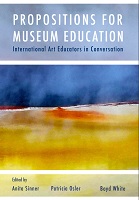Chapter 31 Co-imagining the Museum of the Future: Meaningful Interactions Among Art(efacts), Visitors and Technology in Museum Spaces
Author(s)
Van Even, Priscilla
Wolff, Annika
Steinbeck, Stefanie
Pässilä, Anne
Vanhaelewijn, Kevin
Collection
European Research Council (ERC); EU collectionLanguage
EnglishAbstract
Museums are exploring the potential of digital
technologies and tools for, among other things,
visual literacy education, visitor engagement and
exhibition curation. In this chapter, we will inquire
about the different functions and roles of
technology in the museum space, and we will
examine how to establish a meaningful interaction
between art(efacts), people and tools to improve
curation, visual literacy practices and visitor
experiences. Experiences from the RETINA
project in 2018 have shown us that interactions
without this element of meaningfulness can easily
lead to the development of tools and technologies
that are distractive rather than supportive. Based
on a co-creation workshop in 2021 with different
museum stakeholders and on former museum
research experiences in museum settings, we will
discuss barriers and enablers to good technology
uses in the museum, and supportive and
distractive characteristics of technology.
Furthermore, we will introduce scenarios of what
future museums could look like from the
perspective of technology through the eyes of
youth and museum professionals and researchers.
Keywords
art, HCI , museum spaces, visitor experience, digital technology, artifacts, youth, museum professionals, distractive technology, technology as enabler, co-creation, co-design, authenticity, discovery, collaboration and participationISBN
9781789389135, 9781789389128, 9781789389142, 9781789389159Publisher
IntellectPublication date and place
2024Classification
Educational strategies and policy: inclusion
Cultural studies


 Download
Download